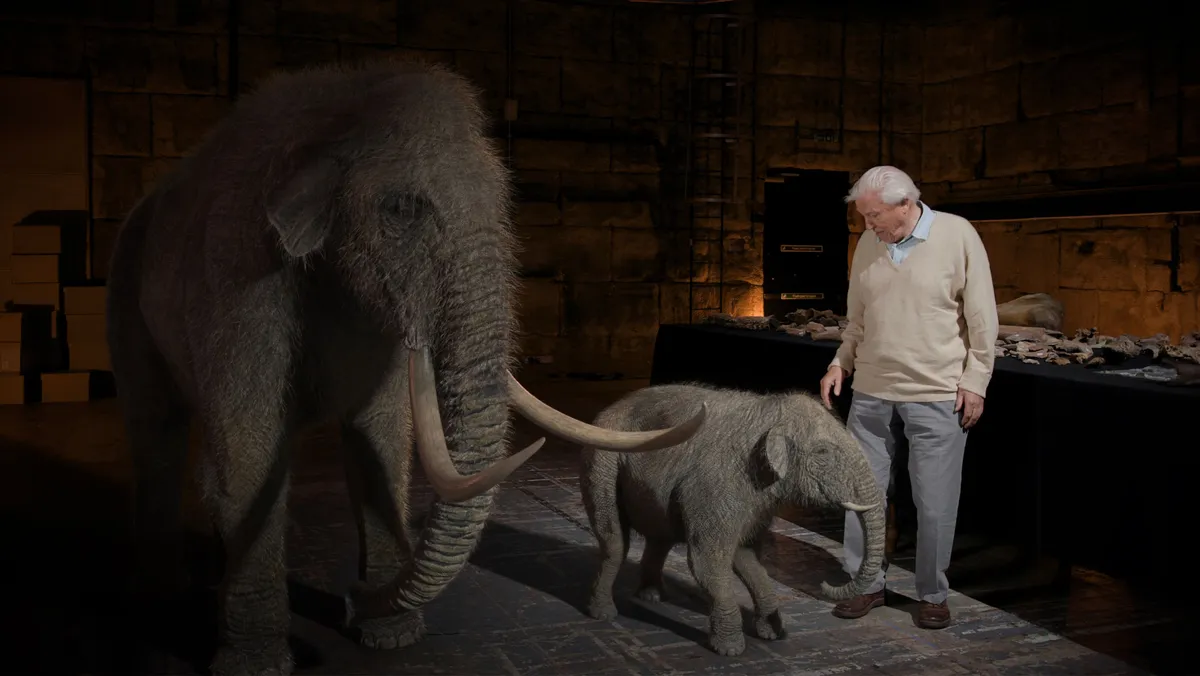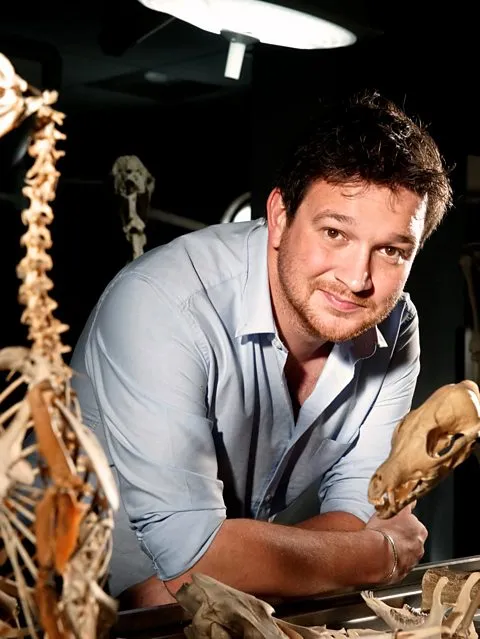Sir David Attenborough’s new show investigates the surprising discovery of a herd of mammoths in Swindon, at a site that was once the riverbed of the Thames. The fossils appear to be hundreds of thousands of years old, making them a very rare find. Attenborough is joined by Prof Ben Garrodand a team of archaeologists on the show, which you can watch on BBC One, Thursday, 30 December, 2021 at 8pm.
Didn’t the whole story start with a chance discovery by amateurs?
Back in 2017 Sally and Neville Hollingworth, who are amateur fossil hunters, came to a talk that I did. Not long afterwards they got in touch asking if they could send me some photos of a discovery they’d made. Long story short, they sent me some photos of Sally lying next to a mammoth tusk.
So I asked them, “Are you in Siberia?”And they said, “No, Swindon.” That wasn’t the answer I expected. I said quickly that I shouldn’t really know about this because, obviously, whoever’s in charge academically would have a fit. But they told me that no one knew it was there; it was just in a quarry, and they asked me if I wanted to be involved. I took the reins and helped put a team together with Lisa Westcott Wilkins from DigVentures and bunch of academics from institutes around the UK.
How did Sir David Attenborough become involved?
I showed him a series of photos when we were at a conference together and it wasn’t hard to hook him on such an amazing project. For me, to work with David on such a big project was always going to be amazing, but what is most lovely about this project is that it showcases the science.
We don’t do that enough in media, unfortunately. It’s often just the end product that’s shown. This shows the process going on behind the scenes, like those 10-minute ‘How we filmed…’ shorts at the end of the big, glossy shows David usually does. This is really seeing who’s involved, what they’re doing, how the discoveries have been made.

Swindon doesn’t immediately strike me as a mammoth hotspot…
If you go back a quarter of a million years, you would have had this diagonal cut across the country, from north Norfolk through Swindon and Oxford, right down to the south coast. North of that would’ve been this huge icy tundra that wasn’t especially hospitable. South of that would’ve been this lush, quite productive zone where you had animals and people migrating backwards and forwards, up and down. You’re talking about a whole range of different animals here: bear, bison, turtles. It would have been a hugely important migratory route a quarter of a million years ago.
Read more about Sir David Attenborough:
- Planet Earth 2: filming wildlife in cities
- Sir David Attenborough at 90
- Has Blue Planet II had an impact on plastic pollution?
So, this is a mammoth graveyard. When we’re talking about mammoths what exactly are we talking about?
The mammoth group is a really interesting group. From fossil records we know that the group spans from about five million years ago, when they first evolved in Africa and then, like our species, spread out and ended up in North America, and across Europe and Asia. Then they diversified. There are about 10 known species from the woolly mammoth right through to steppe mammoths.
The mammoth group as a whole died out maybe as recently as 3,600 years ago. So we still had mammoths roaming the planet when Stonehenge was built. We think of these things as living hundreds of thousands of years ago, but they were around just a few generations ago.

Which species do the Swindon mammoths belong to?
The species that we have in Swindon are steppe mammoths, so steppe as in the Siberian steppes. These things were absolute monsters – the largest mammoths that ever existed. They reached up to about 15 tonnes, maybe even more, and had tusks over four and a half metres long. But the ones we’ve got were right at the end of their range – this particular species came onto the scene about 1.8 million years ago and disappeared about 200,000 years ago.
Ours lived about 200,000 years ago. At that time, this very large species was becoming much smaller, thanks to selection pressure from environmental change, climate change, competition with other big herbivores, and predation from our species and other animals. These [later mammoths] are much more comparable to African/Asian elephants, but we’re still talking 8, 9, 10 tonnes potentially.
What work has been happening at the site since 2017?
The really important thing about this site is that it’s not just a bunch of mammoth bones – that would be cool in itself but, if you have that, there’s no context. If I say to you, this is a piece of mammoth tusk, maybe you can do radioisotope analysis, but you can’t tell me what the environment was really like for the animal it came from.
We’ve got mammoth bones, mammoth tusks, hand-axes from Neanderthals, we’ve got other species such as bears and Megalosaurus, even the mud – I’ve been singing the praises of the mud for so long now. What we have is so well-preserved, we know exactly what the water flowed like, we know what the salinity was like, we know what the oxygen content of the environment was like, we’ve even got freshwater snail shells so we know exactly – from the biggest to the smallest – what animals lived within that environment.
If you’ve heard of the Mary Rose, the ship that sank off the south coast in the 1500s, that served as a snapshot of what life was like in Tudor Britain because so much of it was there; it wasn’t just a cannon, or a cutlass, it was everything. It’s the same thing here but from a quarter of a million years ago.
- Can we bring extinct animals back from the dead?
- What did the woolly mammoth eat?
- Who are the hunters of rare mammoth tusks in Russia?
What new approaches have you been taking?
We’ve been looking at this site from a different perspective to what you would normally see in a palaeontology project. We’ve made sure that we had a team of archaeologists led by Lisa and Brendon Wescott Wilkins. They run DigVentures, a commercial archaeology unit that’s based on citizen science and is outward-facing and very collaborative. They use Light Detection and Ranging (LIDAR) scans and drones, as well as more classic techniques.
We’ve also tried to look at environmental DNA – so taking water and mud samples to see what other animals urinated, defecated, bled to death or decomposed in the area. You might not find the animals themselves, but you might find that a Neanderthal had a wee nearby. We’ve also been using ground-penetrating radar to look at the environment.
The frustrating but cool thing is that we’ve barely scratched the surface.
In my mind we’ve only got maybe 10 per cent of the files that are going to come out of this site. The rest of it is still there, still waiting to be found,
still waiting to be explored and researched properly.
What are your findings so far?
This is one of, if not the only example of what could turn out to be a herd of steppe mammoths found anywhere in the world. Just finding one mammoth is amazing, but we’ve got a herd with babies in it, which is incredible. It doesn’t get any better than that.
We also definitely have an association with Neanderthals here. This is one of the earliest examples, anywhere in the world, of Neanderthals interacting with mammoth remains. I can’t definitively say yet what the link was between them. We don’t know whether they found them dead, and then butchered them, or whether they killed them and then butchered them. But that [research] is all ongoing.
Attenborough and the Mammoth Graveyard airs on BBC One at 20:00 on Thursday, 30 December, 2021.